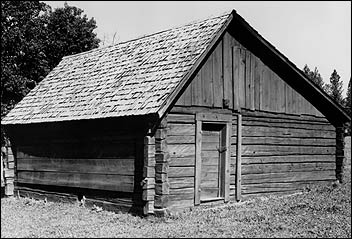Last updated: August 11, 2023
Lesson Plan
Log Cabins in America: The Finnish Experience

- Grade Level:
- Middle School: Sixth Grade through Eighth Grade
- Subject:
- Literacy and Language Arts,Social Studies
- Lesson Duration:
- 90 Minutes
- Common Core Standards:
- 6-8.RH.2, 6-8.RH.3, 6-8.RH.4, 6-8.RH.5, 6-8.RH.6, 6-8.RH.7, 6-8.RH.8, 6-8.RH.9, 6-8.RH.10, 9-10.RH.1, 9-10.RH.2, 9-10.RH.3, 9-10.RH.4, 9-10.RH.5, 9-10.RH.6, 9-10.RH.7, 9-10.RH.8, 9-10.RH.9, 9-10.RH.10
- Additional Standards:
- US History Era 4 Standard 3A: The student understands the changing character of American political life in "the age of the common man."
Curriculum Standards for Social Studies from the National Council for the Social Studies - Thinking Skills:
- Remembering: Recalling or recognizing information ideas, and principles. Understanding: Understand the main idea of material heard, viewed, or read. Interpret or summarize the ideas in own words. Applying: Apply an abstract idea in a concrete situation to solve a problem or relate it to a prior experience. Analyzing: Break down a concept or idea into parts and show the relationships among the parts. Creating: Bring together parts (elements, compounds) of knowledge to form a whole and build relationships for NEW situations. Evaluating: Make informed judgements about the value of ideas or materials. Use standards and criteria to support opinions and views.
Essential Question
What skills and materials do you need to build a log cabin?
Objective
1. To explain the distinctive features of log structures built by Finnish homesteaders in Idaho.
2. To explain how Finns and Swedes influenced the techniques used for building log structures.
3. To describe how the log cabin became so widely used among colonists and later pioneers.
4. To investigate the student's own locality to find out what kind of folk housing was prevalent in their own community.
Background
Time Period: 1700s-1900s
Topics: This lesson could be used in teaching units on the development of the early colonies, trans-Appalachian settlement, or late 19th- and early 20th-century immigration.
Preparation
Log cabins are as American as Fourth of July fireworks, baseball, and the bald eagle. Think of a pioneer and chances are you think of a log cabin: could Daniel Boone or Davy Crockett have lived in any other kind of house? Can you imagine the 1840 election--"Tippecanoe and Tyler, Too!"--without remembering the log-cabin-and-cider campaign? Would we be so impressed with Abe Lincoln if he had learned his letters under a crystal chandelier in a brick, Georgian-style house? Is it conceivable that Laura Ingalls Wilder's little house on the prairie was anything but a snug log structure? Assuredly, log cabins are enmeshed in American history, folklore, and myth.
Lesson Hook/Preview
The log cabin has long been a symbol of American self-sufficiency. The cabin could be quickly built, and it provided a reasonably secure haven in a strange and often hostile environment. Neither arrows nor bullets could penetrate its thick wood walls which--if well-built and carefully chinked--would keep out rain, snow, and cold. Although the cabins could catch fire, this did not happen very often. As people continued to move westward in search of more and better land, they would abandon their cabins knowing they could easily build new ones as long as timber was available. Even in the early 20th century as far western lands opened up to settlement, new immigrants continued to construct log cabins as their first American homes.
Under the Homestead Act of May 20, 1862, those citizens who were the head of a family or at least 21 years of age were offered 160 acres of surveyed land after five years of continuous residence and payment of a registration fee ranging from $26 to $34. Alternatively, land could be acquired at $1.25 an acre after six months' residence. By means of this act, Finnish immigrants settled in Idaho between 1900 and 1930.
Procedure
Getting Started Prompt
Map: Orients the students and encourages them to think about how place affects culture and society
Readings: Primary and secondary source readings provide content and spark critical analysis.
Visual Evidence: Students critique and analyze visual evidence to tackle questions and support their own theories about the subject.
Optional post-lesson activities: If time allows, these will deepen your students' engagement with the topics and themes introduced in the lesson, and to help them develop essential skills.
Vocabulary
folklife / folklore
Homestead Act
Additional Resources
The Institute of Migration
Institute of Migration was founded in 1974 to promote the collection, storage, and documentation of research material relating to international and internal migration. Included on the site is a detailed article documenting everyday life on Finnish American homesteads and statistics regarding the Finnish population in the United States.
Historic American Engineering Record (HABS/HAER)
The HABS/HAER collections document achievements in architecture, engineering, and design in the United States through a comprehensive range of building types and engineering technologies. Search the collection for documentation on numerous "log cabins" throughout the United States. Drawings and photographs, as well as historical data are provided.
Library of Congress:
For a wealth of primary resources on log cabins, search the LOC Digital Collections. Included in the many resources are homesteader life histories written for the Works Progress Administration, sheet music about log cabins, numerous photographs, homesteader legislation, and much more.
National Archives and Records Administration (NARA)
The Archives has placed on its web site a number of items about Western Expansion, including copies of the original Homestead Act and original maps of western areas that were being settled. To find them, visit the NARA Search Engine and enter "Homestead Act."
